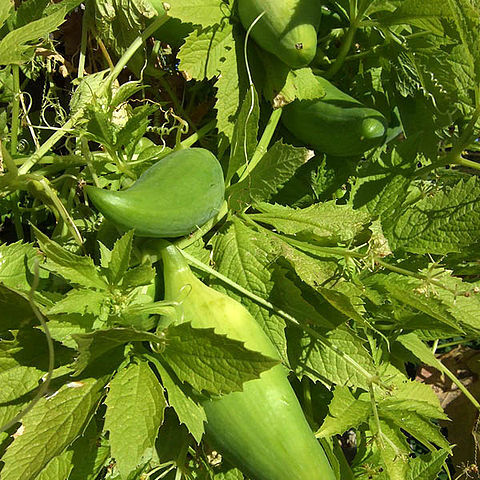Annual vines; stems slender, glabrous. Leaves 5-foliolate, sometimes the two lateral lobes slightly joined at the base and the leaves 3-foliolate, the blade sub-orbicular in outline, 2.5-20 cm long and about as wide, the leaflets lanceolate, the lateral leaflets often pedately lobate, the margins serrulate-dentate to dissected, the apex acute, membranaceous, the upper and the lower surfaces glabrate; petiole 1-8 cm long; tendrils 2-branched. Staminate flowers axillary, paniculate; rachis 10-20 cm long, the 25(-50) flowers confined to the upper '/2-1/4 of the rachis; pedicels ca. 5 mm long, filiform; calyx shallowly cupulate, 3-4 mm wide, greenish white, the lobes obscure or to 2 mm long; corolla 3-6 mm wide, whitish, the lobes 1-2 mm long, broadly lanceolate, the outer surface glabrous, the inner surface papillate, 3-nerved; androecial head sessile, 2.0-2.5 mm in diameter. Pistillate flowers solitary, in the same axils as the staminate flowers; peduncle 6-10 mm long; calyx and corolla as in the staminate flowers; ovary obliquely ovoid, rostrate, 4-6 mm long, unarmed or with a few seta near the base; stigma subglobose. Fruits greenish white, striate, obliquely ovoid, 5-16 cm long, indehiscent, the setae few or none; seeds dark brown, ovoid, com-pressed, 12-16 mm long, the margin irregularly appendaged.
More
Plants annual. Stem robust, multibranched, glabrous. Petiole 5-15 cm; leaf blade 5-pedatisect, leaflets elliptic or elliptic-lanceolate, median leaflet 7-16 × 2-6 cm, base cuneate, margin dentate, apex acuminate; lateral leaflets 5-14 × 2-4 cm. Tendrils 2-fid. Male flowers in a panicle; peduncle 10-23 cm, 20-50-flowered; pedicels filiform, 4-10 mm; calyx tube cupular, ca. 2 × 3-4 mm; segments linear, ca. 2 mm; corolla yellow; segments ovate-triangular, 1.5-2 × 2-2.5 mm, puberulent; filaments connate; anthers circular, 1.5-2 mm. Female flowers: calyx and corolla as in male flowers; ovary 2-3 mm; style 0.5-0.7 mm. Fruit narrowly oblong to narrowly elliptic, 5-7 × 2.5-3 cm, setose, apex acuminate, 8-10-seeded. Seeds black, suboblong, 10-12 × 7-8 mm, margin dentate. Fl. and fr. May-Oct.
A creeping pumpkin family plant. It can easily grow 2 m long. It climbs using tendrils. These can be divided twice or many times. The leaves are lobed and have teeth along the edge. The flowers occur in the axils of leaves. The flowers are small and cream coloured. The fruit are like small cucumbers. They can have stout prickles. They are edible. There are 10 seeds in each fruit.
A tropical plant. It occurs in the Andes. It can be grown in warm temperate places. In the tropics it grows between 2,000-3,000 m above sea level. They grow in Nepal to about 2500 m altitude. In Argentina it grows between 500-2,800 m above sea level. In Yunnan.
More
Not known in a truly wild condition.

